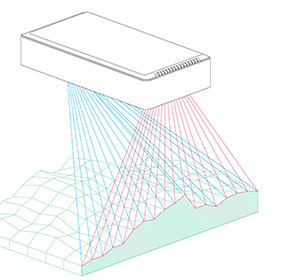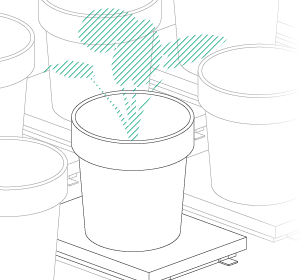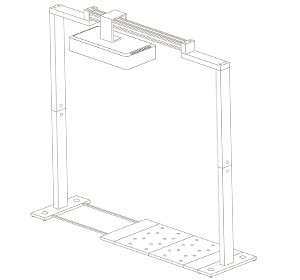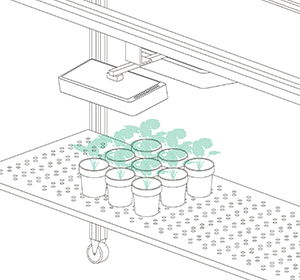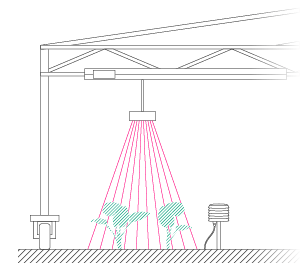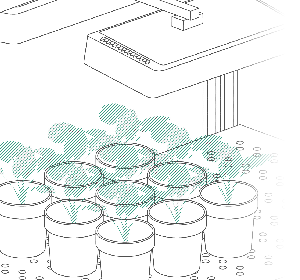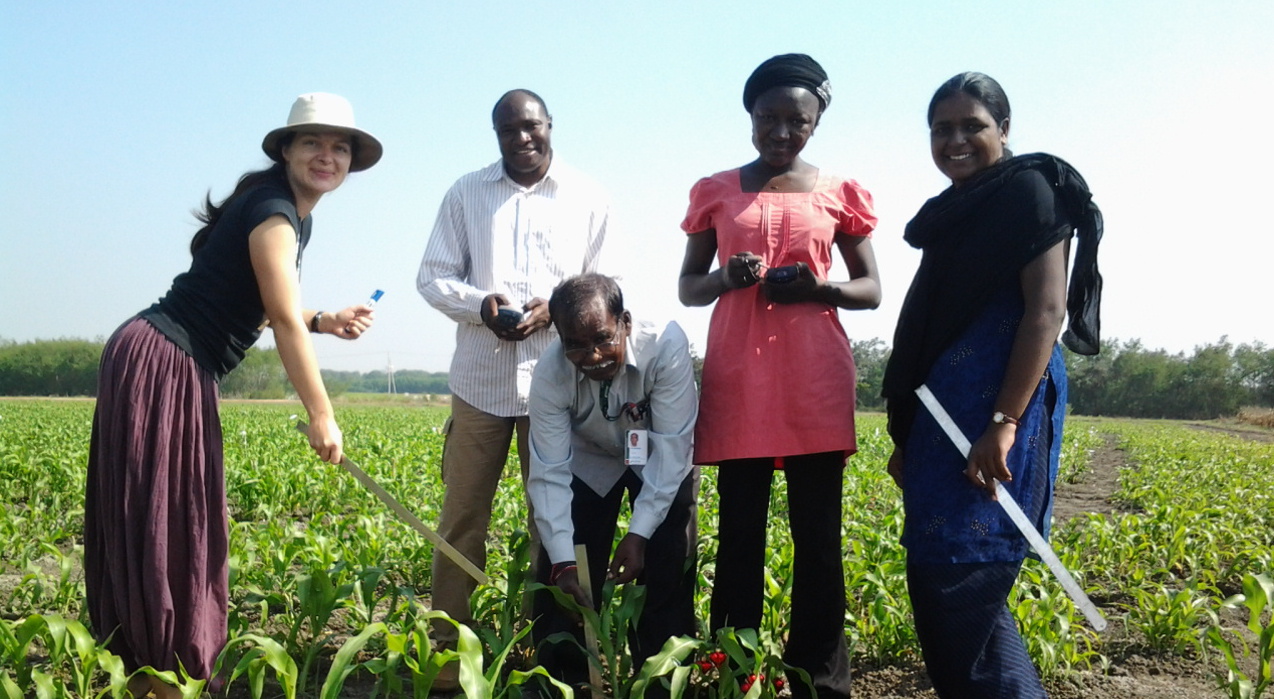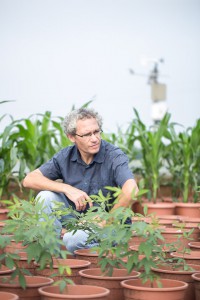Can Field Phenotyping improve the livelihood of millions of households?
Dr. Jana Kholova describes her reseach at ICRISAT and how we established a unique Field Phenotyping platform together to support the research on crops for the semi-arid tropics.
Why the semi-arid tropics should get more research attention…
Within the scope of climate change projections the already harsh conditions for agricultural productions in semi-arid tropics (SAT) would most probably severe. These changes will affect millions of the most vulnerable households living already deeply below the poverty line. One viable option to reverse the inevitable pessimistic future of SAT farming systems is the enhancement of its production and resilience. However, there has been only a marginal progress in this task since last decades because SAT farming systems are characteristic with the most harshest environmental constrains (mainly drought) followed by very low crop production. Maybe for these reasons SAT agro-ecosystems received only limited scientific attention and negligible investments from public-private sector.
Acceleration of breeding; a viable way to improve adaptation of cropping systems in SAT
Since 2006, the main effort of the research team formed around Dr. V. Vadez at ICRISAT had been focusing on bringing together all possible multidisciplinary means and international expertise to facilitate the improvement of SAT agro-ecosystems (with the main focus on adaptation of cropping systems to drought). Since then a lot of evidence has been accumulated determining the options for agriculture production improvement in the SAT (e.g. Vadez et al. 2009, 2010, 2011a&b, 2012, 2013, 2014; Kholová et al. 2010a&b, 2011, 2012, 2013, 2014a&b; Belko et al. 2012; Zaman-Allah et al. 2011a&b; Ratnakumar et al. 2009). One key aspect of this effort includes acceleration of crop improvement efficiency. This requires the accurate definition of the screening criteria relevant for crop production improvement in specific agro-ecologies (precision agriculture, e.g. Vadez et al. 2012; Kholová et al. 2013, 2014). These criteria have been well defined and are basically linked to the physiological mechanisms influencing water use (WU) during the crop cycle (reviewed in Vadez et al. 2013, 2014).
If this approach was to be brought into practice it required a huge quantities of breeding material accurately screened and evaluated for the identified WU-related traits (generally populations of 1000s lines). This task is close to impossible without an automated system and that is where the idea of HT-phenotyping platform construction arouse. However, most of the currently available market options have little or no relevance to carry out the above defined scientific task; i.e. evaluation of germplasm for the main components of WU:
- canopy size & canopy growth dynamics (plant vigor)
- canopy conductivity (H2O transpired per unit of LA per unit of time)
- plant water use & water use dynamics (transpiration in time)
- Interaction of plant WU components with environmental stimuli (e.g. drought, VPD, salinity, micronutrient deficiencies…)
and that all across the crops species, in outdoors conditions and within the short time-intervals.
Top 10 reasons why Phenospex could help…
The main reasons why the Phenospex (PSX) proposed solution for our research question was finally chosen were:
- Our ICRISAT team was given the opportunity to test the prototype and validate the relevance of PSX developed technology in the context of ICRISAT research
- PSX flexibility to develop the technology and facility based on entirely ICRISAT requirements
- PSX eager for continuous development of technologies in order to accurately target ICRISAT research goals
- absolute flexibility, transparency, openness and fair-play approach
- PSX has multidisciplinary dynamic team able to understand the research quest from all possible angles
- totally amazing capability of PSX to work efficiently and provide solutions even in the unsettled conditions of developing countries like India is
- PSX has outstanding maintenance services and attends effectively any problems occurring after the installation of HT-platform
- continuous updates of the PSX technologies in line with the research progress
- PSX developed the tools for data management/analysis according to ICRISAT needs ……
- and overall cost-effectiveness of the all the processes.
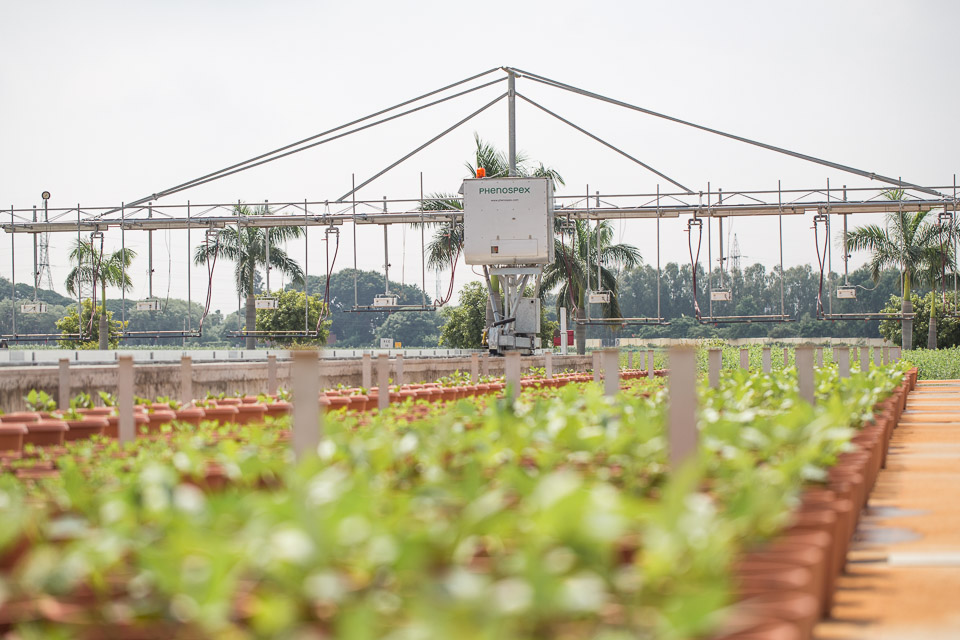
Fig. 2: FieldScan High Throughput Field Phenotyping Plattform at ICRISAT India
Installation of HT-phenotyping platform at ICRISAT in 2013 is clearly the milestone in “research for development” (R&D) approach. The phenotyping concept itself is very unique – i.e. it brings the technology to the plants in the field rather than bringing plants to technology – which finally result in tremendous improvement of phenotyping throughput (currently, the information from 5000 micro-plots can be accessed every 2h along with meteorological data). The analysis of generated phenotypic information should provide the means to bring precision agriculture in practice in a near future. I believe, the rigorous research concepts up-scaled by the highly focused technology-options should lead to improvement of livelihood of millions of households depending on agricultural production in (not only) developing countries.
See our Field Scan System at ICRISAT
References
- Belko N, Zaman-Allah M, Cisse N, Diop NN, Zombre G, Ehlers JD,Vadez V. 2012. Lower soil moisture threshold for transpiration decline under water deficit correlates with lower canopy conductance and highertranspiration efficiency in drought-tolerant cowpea. Functional Plant Biology 39, 306–322.
- Kholová J, Hash CT, Kakkera A, Kocova M, Vadez V. 2010a. Constitutive water-conserving mechanisms are correlated with the terminal drought tolerance of pearl millet Pennisetum glaucum (L.) R. Br. Journal of Experimental Botany 61, 369–377.
- Kholová J, Hash CT, Kumar PL, Yadav RS, Kocova M, Vadez V. 2010b. Terminal drought-tolerant pearl millet Pennisetum glaucum (L.) R. Br. have high leaf ABA and limit transpiration at high vapour pressure deficit. Journal of Experimental Botany 61, 1431–1440.
- Ratnakumar P, Vadez V, Nigam SN, Krishnamurthy L. 2009. Assessment of transpiration efficiency in peanut (Arachis hypogaea L.) under drought using a lysimetric system. Plant Biology 11, 124–130.
- Vadez V, Deshpande SP, Kholová J, Hammer GL, Borrell AK, Talwar HS, Hash CT. 2011a. Stay-green quantitative trait loci’s effects on water extraction, transpiration efficiency and seed yield depend on recipient parent background. Functional Plant Biology 38, 553–566.
- Vadez V, Krishnamurthy L, Hash CT, Upadhyaya HD, Borrell AK. 2011b. Yield, transpiration efficiency, and water-use variations and their interrelationships in the sorghum reference collection. Crop & Pasture Science 62, 645–655.
- Vadez V, Kholová J, Yadav RS, Hash CT. 2013. Small temporal differences in water uptake among varieties of pearl millet (Pennisetum glaucum (L.) R. Br.) are critical for grain yield under terminal drought. Plant Soil 371, 447–462
- Vadez V, Kholová J, Zaman-Allah M, Belko N. 2014a. Water: the most important “molecular” component of water stress tolerance research. Functional Plant Biology 40, 1310–1322.
- Vadez V, Kholová J, Medina S, Aparna Kakkera A, Anderberg H 2014b. Transpiration efficiency: new insight into an old story. Journal of Experimental Botany, doi:10.1093/jxb/eru040
- Zaman-Allah M, Jenkinson DM, Vadez V. 2011a. Chickpea genotypes contrasting for seed yield under terminal drought stress in the field differ for traits related to the control of water use. Functional Plant Biology 38, 270–281.
- Zaman-Allah M, Jenkinson DM, Vadez V. 2011b. A conservative pattern of water use, rather than deep or profuse rooting, is critical for the terminal drought tolerance of chickpea. Journal of Experimental Botany 62, 4239–4252.
- Kholová J, Vadez V. 2013 Water extraction under terminal drought explains the genotypic differences in yield, not the anti-oxidants changes in leaves of pearl millet (Pennisetum glaucum (L.) R.Br.) Functional Plant Biology 40, 44–53. doi:10.1071/FP12181
- Kholová J, Nepolean T, Hash CT, Supriya A, Rajaram V, Senthilvel S, Kakkera A, Yadav RS, VadezV (2012) Water saving traits co-map with a major terminal drought tolerance quantitative trait locus in pearl millet (Pennisetum glaucum (L.) R.Br.) Molecular Breeding 30, 1337–1353.
doi:10.1007/s11032-012-9720-0 - Kholová J, McLean G, Vadez V, Craufurd P, Hammer GL. 2013. Drought stress characterization of post-rainy season (rabi) sorghum in India. Field Crops Research 141, 38–46. doi:10.1016/j.fcr.2012.10.020
- Kholová J, Hash CT, Kocová M, Vadez V. 2011. Does the control of reactive oxygen species matter for the terminal drought tolerance of pearl millet (Pennisetum glaucum (L.) R.Br.)? Environmental and Experimental Botany 71, 99–106.
- Vadez, V, Soltani, A, Sinclair, T R. 2012. Modelling possible benefits of root related traits to enhance terminal drought adaptation of chickpea. Field Crops Research, 137 (20). pp. 108-115. ISSN 0378-4290
- Kholová J, Tharanya M, Sivasakthi K, Srikanth M, Baddam R,. Hammer GL, McLean G, Deshpande S, Hash CT, Craufurd PQ, Vadez V Modelling the effect of plant water use traits on yield and stay-green expression in sorghum Functional Plant Biology http://dx.doi.org/10.1071/FP13355
About Jana
 Jana did her graduate studies and PhD in Plant Genetics & Physiology in the Dept. of Genetics and Microbiology at Charles University in Prague (Czech Republic). Besides her passionate love for stone frogs, Jana is working as a scientist at ICRISAT in Andrah Pradesh (India) in the team of Dr. Vincent Vadez where she works since 2009. ICRISAT is a non-profit, non-political organization that conducts agricultural research for development in Asia and sub-Saharan Africa. ICRISAT and its partners help empower the poor people to overcome poverty, hunger and a degraded environment through better agriculture. It belongs to the Consortium of Centers supported by the Consultative Group on International Agricultural Research (CGIAR). Jana’s work at ICRISAT is focusing on plant stress physiology, genetics and modelling exploting various field phenotyping technologies.
Jana did her graduate studies and PhD in Plant Genetics & Physiology in the Dept. of Genetics and Microbiology at Charles University in Prague (Czech Republic). Besides her passionate love for stone frogs, Jana is working as a scientist at ICRISAT in Andrah Pradesh (India) in the team of Dr. Vincent Vadez where she works since 2009. ICRISAT is a non-profit, non-political organization that conducts agricultural research for development in Asia and sub-Saharan Africa. ICRISAT and its partners help empower the poor people to overcome poverty, hunger and a degraded environment through better agriculture. It belongs to the Consortium of Centers supported by the Consultative Group on International Agricultural Research (CGIAR). Jana’s work at ICRISAT is focusing on plant stress physiology, genetics and modelling exploting various field phenotyping technologies.

